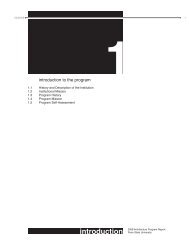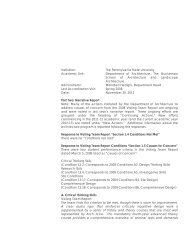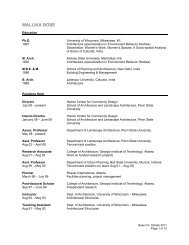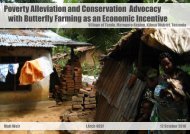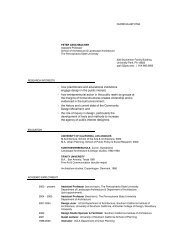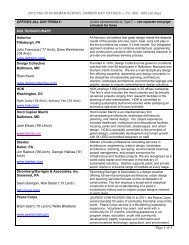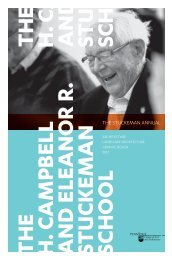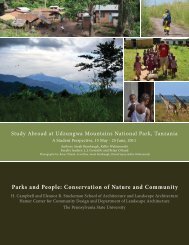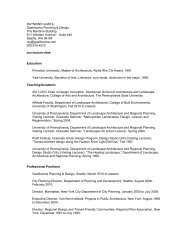prioritizing future development and growth - Stuckeman
prioritizing future development and growth - Stuckeman
prioritizing future development and growth - Stuckeman
- No tags were found...
You also want an ePaper? Increase the reach of your titles
YUMPU automatically turns print PDFs into web optimized ePapers that Google loves.
Saplings growing at school nurseryWood collected from the National Park on aThursday - the day residents are permitted tocollect deadwood from the forestHomes are located directly adjacent to theNational ParkKisawasawa has an abundance of vegetation<strong>and</strong> canopy coverage within the villageFUEL SECURITYInventory & AnalysisDependence on Deadwoodfor FuelIn the Kilombero Valley the average household of five people consumesone to two bundles of firewood per week for domestic use (Harrison2006b). A bundle of firewood sells for about TSh. 600 (Harrison2006b). If people resorted to buying the firewood, which currently theyare collecting for free, this would impose a cost of between TSh. 30,000<strong>and</strong> TSh. 60,000 on households annually - making this source ofenergy cost prohibitive for most families. While rice husks can provideabout one month’s worth of fuel for residents of Kisawasawa, the fuelefficient woods stoves are the best possibility for drastically decreasingKisawasawa’s energy dem<strong>and</strong>s.Woodlots must be established in Kisawasawa in order to provide fuelwoodfor residents after the closure of Udzungwa Mountaions NationalPark’s borders for deadwood collection on 30 June 2011. Saplings forthe woodlots should be grown in nurseries run by the schools <strong>and</strong> othercommunity groups in order to produce healthy trees in the woodlotsDeadwood for FuelTrees needed per year per household: 20-medium sizedtrees (6 m high)Wood used per household annually with inefficient woodstoves: 3486.6 kgTrees needed per year per household with fuel efficient stove:8.8 treesTrees produced per hectare of woodlot: 400 treesApproximate number of households: 487.4 householdsWood (kg) x 1.18 = Rice husk energy equivalent (kg)Annual Deadwood Consumption for KisawasawaTrees needed per year per household: 20-medium sized trees (6m high)20 trees x 487.4 households = Trees needed for Kisawasawa annuallyTrees needed for Kisawasawa annually: 9,748 medium sized treesTrees produced per hectare of woodlot: 400 trees9,748 trees / 400 trees = Hectares of woodlot needed annuallyHectares of woodlot needed annually for Kisawasawa = 24.37 hectares20Trees needed peryear per householdwith inefficientstoves8.8 8.9%Trees neededper year withefficient woodstovesAnnual Deadwood Consumption for Kisawasawawith Energy Efficient Wood StovesTrees needed per year per household with fuel efficient stove: 8.8 trees8.8 trees x 487.4 households = Trees needed for Kisawasawa annuallyTrees needed for Kisawasawa annually with fuel efficient stove: 4,289.12 treesTrees produced per hectare of woodlot: 400 trees4,289.12 trees / 400 trees = Hectares of woodlot needed annuallyHectares of woodlot needed annually for Kisawasawa = 10.72 hectaresRice Husk Contribution to Fuel NeedsPercent of fuelneeds that couldbe met with ricehusksWood utilized per household per year: 3,486.6 kg3,486.6 kg x 487.4 households = Wood utilized by Kisawasawa annuallyWood utilized annually by Kisawasawa: 1,699,368.84 kgWood (kg) x 1.18 = Rice husk energy equivalent (kg)1,699,368.84kg x 1.18 = Rice husk energy equivalentEquivalent energy in rice husks: 2,005,255 kgAmount of rice husks from Kisawasawa’s rice fields per year: 178,053.8178,053kg / 2,005,255 kg = percent of Kisawasawa’s fuel needs met byrice husksPercent of Kisawasawa’s fuel needs met by rice husks: 8.9%2,005,255kg - 178,053kg = Difference between fuel needed <strong>and</strong> fuelavailable in rice husksDifference between fuel needed <strong>and</strong> fuel available: 1,827,201 kg rice husksWood (kg) x 1.18 = Rice husk energy equivalent (kg)1,827,201 kg / 1.18 = Wood energy equivalentEquivalent energy in wood= 1,548,475.8 kgWood utilized annually by Kisawasawa: 1,699,368.84 kg1,699,368.84 kg - 1,548,475.8 kg = Energy obtained by rice husksHectares of woodlot needed annually for Kisawasawa = 24.37 hectaresPercent of Kisawasawa’s fuel needs met by rice husks: 8.9%24.37 - (24.37 ha x .089) = Hectares of woodlot needed if with rice huskstoves are utilizedHectares of woodlot needed if with rice husk stoves are utilized: 22.2 haPRIORITIZING FUTURE DEVELOPMENT AND GROWTH:ADDRESSING FOOD, FUEL, WATER, AND INFRASTRUCTURE IN KISAWASAWA, TANZANIA13



